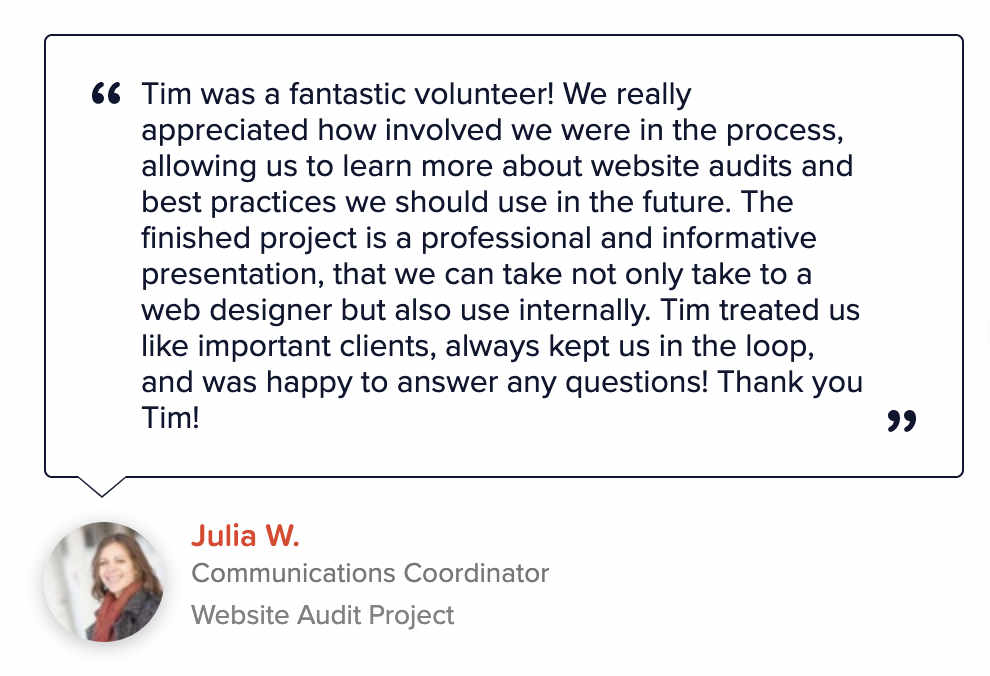In part one of the site audit I talked about how and why I decided to work with 350 Colorado as well as how we used a few dot voting exercises to define the audience, define their primary goal, and design principles for their web development project. With those defined we were now ready to start talking to people.
User Experience Interviews
We scheduled 1-on-1 interviews with volunteers of 350 Colorado to understand how they found 350 Colorado, what motivated them to take action, how they take action, and what they use the website for. I also set up interviews with some DockYard employees to gauge the causes and motivations people outside 350 experienced. From the interviews we were able to better understand people’s motivations and breakdown our target audience into four personas that we labeled The Time Constrained, The Cause Driven, The Professional Networker, and The Social Butterfly.
The Time Constrained typically don’t take action for the causes they care about they’re short on time. They will participate if it’s convenient and lines up with what they already have going on. It’s hard for this persona to commit long-term because their schedule is packed or constantly changing due to work or family needs. If we can provide these users with a more flexible way to volunteer and provide them clear details on what is expected of them, then they might be inclined to take action.
The Cause Driven persona has an overwhelming passion to fight for what’s right and leave a better legacy. This user is typically highly educated on the subject matter and already heavily involved. They want to feel the satisfaction of accomplishing standing up for the cause, and they want to have input on what events the organization participates in.
The Professional Networker joins an organization to expand their career opportunities. They’re either beginning a career journey or in the middle of switching jobs. They want to be part of a network of passionate people that are doing work that interests them personally, they know who is in the organization already, and they know how they can fit into the group. They’re usually self-motivated in researching and joining organizations.
The Social Butterfly joins an organization to expand their social circle and feel like they’re contributing to something meaningful. They look for a sense of community and camaraderie in an organization that focuses on people power. They want to meet regular, like-minded people in their area. They’re usually unsure of how to get plugged in to a movement, so they need clear details on how they can get started.
 
The Results
With a new perspective based on the goals that were defined and what we learned through the interviews, I took another look at the site structure and the site’s analytics. The landing page drop-off rate was hovering around 69%, much higher than the average of 40–55% for other nonprofits. 350 Colorado was converting only 0.37% of site visitors to action takers as compared to the average of 1.95%. One area where they were seeing above-average success was for the average donation per year. Combining all of this information and using the average for other nonprofits as our target, we put together a few hypotheses statements about which site improvements could have the biggest impact:
-
If we give new site visitors a more streamlined landing page with clear calls to action, they will be more likely to explore the site, which will result in less landing page drop offs and more engagement.
-
If we give site visitors a more organized and detailed view around the opportunities to get involved, they will be more likely to explore the volunteer possibilities and feel confident about what they can contribute, which will result in more visitors taking action.
-
If we give site visitors a more organized view of events, they will be able to easily see what’s happening, which will result in more attendance and insight on events.
-
If we give site visitors a Contact page with clear information on how to get in touch with us, they will be able to easily ask questions or find out more info, which will result in visitors feeling more connected and taking more action.
These were the priorities to address given the audience and goals. They leave room for exploration of the problem area while providing a roadmap for fixes during the implementation phase. I also provided a list of other detailed changes that 350 could make to better align the site with their goal and their design principles.
By conducting these exercises we were able to go beyond changes to the site that were based on personal preference or assumptions and provide a list of improvements based on data and insights. The results from the workshops set a common goal that we were all working towards with clear parameters and 350 Colorado can use the the design principles for future debates about the site’s design and content. They can even solve new problems that arise using the dot voting. Their next step is to find a visual designer with an in-depth knowledge of Wordpress to start working on the list of priorities.

I learned some tricks for facilitating remote workshops during this project, which I hope to share in a future blog post. It was challenging to work on such limited time and make decisions that would have a real impact for the organization, but the group was open minded and willing to trust the process, which made them perfect design partners for this type of work. The ability to do this type of professional development on a real web development project was invaluable. I was facing challenges that are encountered in the world, real scenarios, real data, and most importantly, real people.
DockYard is a digital product agency offering custom software, mobile, and web application development consulting. We provide exceptional professional services in strategy, user experience, design, and full stack engineering using Ember.js and Elixir. With staff nationwide, we have consultants in key markets across the United States, including San Francisco, San Diego, Phoenix, Dallas, Chicago, Detroit, Miami, Pittsburgh, Baltimore, and New York.


